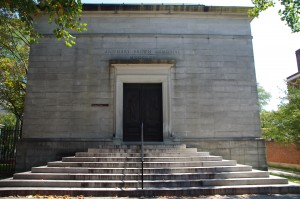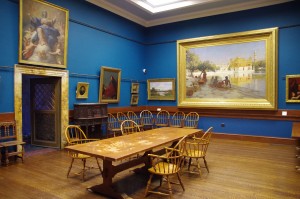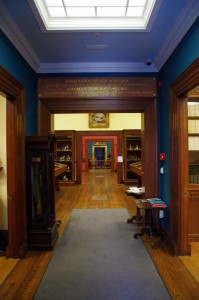“Behind Every Door is a Story,” Doors Open Rhode Island write on their website. Their mission is to acquaint Providence city dwellers and workers with the hidden-in-plain-sight places they may walk or drive past every day without realizing what is inside. On Saturday, Sep 23, they will hold a citywide free festival featuring many sites welcoming “open house” visitors that the event web page describes as “Providence Unlocked: Imagine receiving a set of keys to historic homes, theaters, sacred spaces, secret vaults, studios and more, for free. For one day, the Doors Open Rhode Island Festival will provide you with free, special access to over 20 one-of-a-kind places across Providence.”
“There are no tickets or reservations. You just show up. The doors are open to you. Some of the sites might have lines,” said Caroline Stevens, program director of Doors Open RI. “This is very much a community event, so every site we view as the start of a relationship between the people of Providence and these places.” The festival runs 10am – 6pm, although most individual sites have slightly more limited hours. (There is also a special evening program at Aurora.) RIPTA is providing free bus service for attendees to access multiple sites without worries about cars and parking, and sites will have passes or wearable buttons to facilitate this.
“This program is not just about architecture, but what makes Providence the remarkable city that it is, which is art, culture, and history, all of these things,” Steven said.
The full list of participating venues is on the festival’s web page: doorsopenri.org/festival/#sites

(photo: Michael Bilow)
Motif was given a sneak peak of the Annmary Brown Memorial (10am-4pm), 21 Brown St. Constructed by Rush Hawkins in 1907 because he was heartbroken over the death in 1903 of his wife, a member of the Brown family, the building houses a substantial but idiosyncratic collection of art that has been maintained to the extent possible just as he left it. To the Providence Daily Journal explaining his gift to the people of the city, he wrote: “For both the husband and the wife a suitable resting place has been provided; but the appearance of the interior is cheerful, the forms and construction are simple, and no atmosphere of gloom is present.” Stevens observed, “Because it is a mausoleum it doesn’t look particularly inviting, so the festival will be a rare opportunity to feel welcomed into the space.”

(photo: Michael Bilow)
Peter Harrington, curator at the Anne S.K. Brown Military Collection at Brown University, explained that he oversees the memorial as a side responsibility, since it is now the responsibility of the university after Mr. Hawkins was unexpectedly run down by a taxi on Fifth Avenue in Manhattan at the age of 89, having failed to provide sufficient funds for its maintenance. The couple are interred in a mausoleum at the opposite side of the building from the entrance and, Harrington explained, the university pays for an annual wreath and floral arrangement on the tomb on the March 9 birthday of Annmary, in accordance with Rush’s will. Two large panels by the major American Orientalist painter Edwin Lord Weeks are on permanent exhibit. According to Harrington, Rush Hawkins also collected incunabula, manuscripts on early American witch trials, and – oddly – books written by people named “Hawkins.” (The large Mazansky Collection of British swords and miniatures on display is part of the Anne S.K. Brown Military Collection and is not directly related to Rush or Annmary Hawkins, Harrington said.)

(photo: Michael Bilow)
Rush Hawkins was a colonel on the Union side in the Civil War, and according to Harrington was promoted to the rank of general shortly after the end of the war. Harrington said that Hawkins’ military career ended when he sent a letter to President Abraham Lincoln criticizing General George McClellan for his notorious reluctance to fight; Lincoln later conceded to Hawkins, Harrington said, that the criticism was valid. One of the more interesting artifacts is a large box with a note on the outside in Mr. Hawkins’ handwriting saying the contents are the letters exchanged almost daily by the couple during the war and asking that they be destroyed to preserve privacy – and the box is empty.
Sites available to visit range from places usually not accessible to the public, such as the studios of RI Public Radio (noon – 6pm, handicap accessible), 1 Union Station, to less accessible places within otherwise accessible places, such as the history of printing room at the Providence Public Library (9:30am – 2pm, handicap accessible), 225 Washington St, with old printing presses, type cases, and type specimen books. Some are difficult to access without special arrangements, such as the Benefit Street Arsenal (10am – 6pm), 176 Benefit St, a small medieval-style castle built in 1842 in the Dorr War era and now home to the Providence Marine Corps of Artillery, containing Civil War artifacts.
Several sites focus on the history of the city. The Episcopal Cathedral of St. John (noon – 6pm), 276 North Main St, has been vacant for many years but visitors can see its new life as the Center for Reconciliation, a museum focused on race and the local slave trade. The Roman Catholic Cathedral of Saints Peter and Paul (10am – 4pm, handicap accessible), 30 Fenner St, is a classic Gothic Revival structure that faces the nearly-forgotten Cathedral Square plaza designed by internationally renowned architect I.M. Pei, and the cathedral itself is the surviving twin with the Cathedral of St. Joseph in Hartford, CT, both completed in 1889 but the latter destroyed by fire in 1956.
Government buildings have often overlooked interior spaces, such as the attic archives of Providence City Hall (10am – 6pm), 25 Dorrance St, even containing old police mug shots. The Rhode Island State House (10am – 6pm, handicap accessible), 82 Smith St, featuring what is believed to be the fourth largest self-supporting dome in the world (St. Peter’s Basilica in Rome and the Taj Mahal in India are first and second on that list), was completed in 1904 on a design by architects McKim, Mead and White – the latter of whom, Stanford White, was the victim of “the murder of the century” in 1906 by the jealous husband of Evelyn Nesbitt, “the girl in the red velvet swing.” A special exhibit on the Gaspee affair will be part of the State House tour, Stevens said.
More directly involved in murder, the Victorian-era Barnaby Castle (10am – 3pm, handicap accessible), 299 Broadway, was owned by Josephine Barnaby who became the victim of the first known instance of murder by mail when she drank a gift of whiskey laced with arsenic; a contentious trial produced a conviction that was overturned on appeal and ended inconclusively with the death of the defendant, a story told in some detail by Mrs. Barnaby’s great-grandson Conrad Barnaby in his 1983 book, A Revolting Transaction.
Associated with crime of a very different sort, Hudson Furs (10am – 4pm), 101 Cranston St, was the scene of the Bonded Vault Robbery in 1975, when Mafia-connected robbers stole tens of millions of dollars in cash, gold, jewels and other loot stored by other mobsters in one of the largest thefts in American history.
A few entirely new spaces within existing spaces invite visitors, including the grand opening of the new pavilion at Grace Episcopal Church (10am – 5pm, handicap accessible), 300 Westminster St, a “light-filled modern complement to the nation’s first asymmetrical Gothic Revival church” built in 1846 and featuring a Tiffany stained-glass window. Visitors will be given the rare opportunity to tour the interior of the iconic copper dome 100 feet above street level at Beneficent Congregational Church (10am – 4pm), 300 Weybosset St.
The John Brown House (10am – 4pm), 52 Power St, was built in 1788 by an influential and wealthy politician and slave trader. The Stephen Hopkins House (10am – 9:30pm), 15 Hopkins St, built in 1707 is the oldest house in Providence (although twice relocated) and was the home of the signer of the Declaration of Independence, 10-term governor (when the term was only one year), and host to George Washington who visited twice.
The RISD Naure Lab (10am-4pm, handicap accessible), 13 Waterman St, has more than 80,000 specimens and explores the connection between nature and art. The RISD Textile Lab (10am – 2pm), 7 North Main St – Metcalf Bldg, features a working, modernized, industrial Jacquard loom. Ladd Observatory (11am – 3pm, handicap accessible), 210 Doyle Ave, was frequented by amateur astronomy enthusiast H.P. Lovecraft and has much of its original equipment intact from the 19th and early 20th Centuries; solar observing will be available if the weather co-operates.
Some sites are notable primarily for their creative reuse of space and materials. The Box Office (10am – 4pm), 460 Harris Ave, is a famously unusual multi-colored building constructed from 37 shipping containers – what Stevens called “cargo-tecture” – but visitors will be able to go inside and tour its office spaces rather than just see it from the outside as they pass on the highway. “At the Box Office, a couple of the interior designers and art firms in those spaces will open their doors as well, taking advantage of this as an opportunity to grow their own perspective,” Stevens said. The headquarters of the Rhode Island Foundation (noon – 6pm, handicap accessible), 1 Union Station, was originally the main train station in the city and was rehabilitated after being nearly destroyed by fire twice, once in 1896 and once in 1987. Nail Communications (10am – 6pm, handicap accessible), 63 Eddy St, is an advertising agency whose desks are described as “metal meets Big Nazo.”
The Columbus Theater (10am – 4pm), 270 Broadway, started in 1926 as a vaudeville venue and now hosts films and live performances. Atlantic Mills (10am – 4pm), 120 Manton Ave, is a commercial building a century-and-a-half old that was a factory before labor laws existed, but how holds a variety of for-profit business, non-profit organizations such as the archives and collection of the Retro Computer Society, and a well known flea market. The Arcade (10am – 3pm, handicap accessible), 130 Westminster St, built in 1828, is generally believed to be the first shopping mall, and is now a mixed-use combination of businesses on the lower floors and micro-living loft spaces on the upper floors.
Aurora, 276 Westminster St, will host a special evening event, “19th Century Providence in 3D,” a 45-minute stereopticon presentation by historian Ned Connors, with three shows beginning, respectively, at 5pm, 6:15pm, and 7:30pm; a cash bar will be available.
This is the organization’s first citywide festival in Providence, Stevens said, and she is hoping for about 2,500 visitors throughout the day-long event. “It just depends upon how many people find out about it and what the weather is like,” Stevens said. “This is part of a worldwide network of these events. Part of how I got the number 2,500 is Doors Open Lowell [MA] has been going on for over a decade and they get 2,500 people, but over three days… Providence is a slightly bigger city, so maybe we’ll get 2,500 for the day. When I ran this program in Chicago, now they’ve expanded to 200 sites for 100,000 visitors, so I can’t compare what’s happening here in Providence to that.” A Doors Open RI event in June at the historic Congregation Sons of Jacob Synagogue in the North End of Providence, the turn-of-the-century center of Jewish life in the state, drew 400 people, Stevens said, but it will not be part of the festival because it is being held on a Saturday.
“I’ve found that when people are connected to the places in their communities, that they care about those places more. Learning the stories, reading the stories, will hopefully have the power to transform visitors into advocates of places and ambassadors of these places… and ultimately developing a greater sense of pride… for both the people and the places,” Stevens said. “It’s just one day, but in my experience doing this in Chicago, it can have a really tremendous impact because people look at the city in a different way after this event. ‘I feel a sense of ownership where I live. I can have access. I’ve been there. I’ve seen that, let me tell you about it.’”
Doors Open RI Festival web site: doorsopenri.org/festival; Facebook event: facebook.com/events/474747432894621


